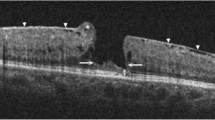Abstract
The purpose of this study was to describe the incidence, clinical characteristics, and outcome of eccentric macular holes presenting after vitrectomy and internal limiting membrane (ILM) peeling for the treatment of macular pathology and discuss the pathogenesis of holes formation. A retrospective, noncomparative, interventional case-series study of five patients who developed eccentric macular holes postoperatively following vitrectomy in 198 consecutive patients who underwent ILM peeling for idiopathic macular hole and epiretinal membrane formation between 2008 and 2015. Five patients (2.5 %) developed full-thickness eccentric macular holes postoperatively. Three patients presented with a single eccentric macular hole, one patient had an eccentric hole after a failed idiopathic macular hole surgery and one patient developed four eccentric macular holes. The mean diameter of the holes was 584 μm (range 206–1317 μm) and the average time of holes formation after vitrectomy was 27.7 weeks (range 1–140 weeks). Postoperative best-corrected visual acuity ranged from “counting fingers” to 20/25. The eyes with the holes distant from the fovea had the best final visual acuity. No further intervention was attempted and no complications occurred. The mean follow-up time was 26.8 months. The postoperative macular holes after vitrectomy and ILM peeling were variable in number, size, and time of appearance but remained stable and were not associated with any complications. The pathogenesis of macular holes is most consistent with contraction of the residual ILM or secondary epimacular proliferation probably stimulated by ILM peeling.


Similar content being viewed by others
References
Rubinstein A, Bates R, Benjamin L, Shaikh A (2005) Iatrogenic eccentric full thickness macular holes following vitrectomy with ILM peeling for idiopathic macular holes. Eye 19:1333–1335
Steven P, Laqua H, Wong D, Hoerauf H (2006) Secondary paracentral retinal holes following internal limiting membrane removal. Br J Ophthalmol 90:293–295
Mason JO III, Feist RM, Albert MA Jr (2007) Eccentric macular holes after vitrectomy with peeling of epimacular proliferation. Retina 27:45–48
Sandali O, El Sanharawi M, Basli E et al (2012) Paracentral retinal holes occurring after macular surgery: incidence, clinical features, and evolution. Graefes Arch Clin Exp Ophthalmol 250:1137–1142
Rush RB, Simunovic MP, Aragon AV II, Ysasaga JE (2014) Postoperative macular hole formation after vitrectomy with internal limiting membrane peeling for the treatment of epiretinal membrane. Retina 34:890–896
Yeh S, Bourgeois KA, Benz MS (2007) Full-thickness eccentric macular hole following vitrectomy with internal limiting membrane peeling. Ophthalmic Surg Lasers Imaging 38:59–60
Kozak I, Freeman WR (2006) Nonprogressive extrafoveal retinal hole after foveal epiretinal membrane removal. Am J Ophthalmol 141:769–771
Wolf S, Schnurbusch U, Wiedemann P et al (2004) Peeling of the basal membrane in the human retina: ultrastructural effects. Ophthalmology 111:238–243
Querques G, Prascina F, Iaculli C, Noci ND (2008) Retinal toxicity of indocyanine green. Int Ophthalmol 28:115–118
Karayanan R, Kenney MC, Kamjoo S et al (2005) Toxicity of indocyanine green (ICG) in combination with light on retinal pigment epithelial cells and neurosensory retinal cells. Curr Eye Res 30:471–478
Uemoto R, Yamamoto S, Takeuchi S (2004) Epimacular proliferative response following internal limiting membrane peeling for idiopathic macular holes. Graefes Arch Clin Exp Ophthalmol 242:177–180
Author information
Authors and Affiliations
Corresponding author
Ethics declarations
Conflict of interest
The authors declare that they have no conflict of interest.
Ethical approval
The study protocol followed the principles in the Declaration of Helsinki. Informed consent was obtained from all patients, and the present study was approved by the institutional review board of “G. Gennimatas” General Hospital, Athens, Greece.
Rights and permissions
About this article
Cite this article
Brouzas, D., Dettoraki, M., Lavaris, A. et al. Postoperative eccentric macular holes after vitrectomy and internal limiting membrane peeling. Int Ophthalmol 37, 643–648 (2017). https://doi.org/10.1007/s10792-016-0320-6
Received:
Accepted:
Published:
Issue Date:
DOI: https://doi.org/10.1007/s10792-016-0320-6




